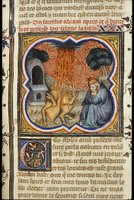Circumcision and Cutting a Covenant
Q: My Bible study group is stumped. The first passage we had trouble with is in Genesis 15 when Abram is told to take various animals and birds and cut the animals in half, but not the birds. The question posed is “what is the significance of the animals being cut in half?” We are not able to work that one out. The follow up is in Genesis 17:1-14, where we get into circumcision. The question is why God chose circumcision to identify his people and how does it refer back to the animals being cut in Genesis 15. Any insight would be appreciated.
 A: The Hebrew Scriptures often speak of “cutting” a covenant. Some Bible translations pick up the word, others translate “cut” as “make,” “establish,” or some such. What you read in Genesis 15 is just that — cutting. Furthermore, we must note that God, not Abram, who initiated and completed the covenant. Verse 12 shows that after guarding the animals of the sacrifice until sundown, Abram fell asleep. “When the sun had gone down and it was dark, behold, a smoking fire pot and a flaming torch passed between these pieces. On that day the Lord made a covenant with Abram. (v. 17)” Pay attention to the smoking fire pot and flaming torch: They’ll be back, in one form or another, in the Exodus (the pillar of fire and the cloud), in tabernacle and temple, in the vision of Isaiah, and in the Revelation to St. John.
A: The Hebrew Scriptures often speak of “cutting” a covenant. Some Bible translations pick up the word, others translate “cut” as “make,” “establish,” or some such. What you read in Genesis 15 is just that — cutting. Furthermore, we must note that God, not Abram, who initiated and completed the covenant. Verse 12 shows that after guarding the animals of the sacrifice until sundown, Abram fell asleep. “When the sun had gone down and it was dark, behold, a smoking fire pot and a flaming torch passed between these pieces. On that day the Lord made a covenant with Abram. (v. 17)” Pay attention to the smoking fire pot and flaming torch: They’ll be back, in one form or another, in the Exodus (the pillar of fire and the cloud), in tabernacle and temple, in the vision of Isaiah, and in the Revelation to St. John.In the ancient Middle East, a covenant was often made by the sacrifice of an animal or animals. The two covenanting parties involved would walk between the halves. Among other things, this signified the seriousness of intent, saying in effect, “May this happen to me if I violate the covenant.” Another reference to this practice — and the attendant threat to violaters — is in Jeremiah 34:18-19. As for why the birds weren’t divided, I can’t find a good answer. Perhaps they were just too small.
Notice in Genesis 15 that only God passed among the halves: He would keep both sides of the covenant, knowing that sinful men, even His beloved Abram could not. When you think in these terms, the promise to the Servant in Isaiah 42:6 takes on even greater meaning, “I have given you as a covenant for [of] the people.” In Christ, One finally stood on our side who could and did keep the agreement perfectly.
You can make one very obvious connection of circumcision with the covenant when you see that a covenant is cut, just as the foreskin is cut in circumcision. I’ve heard many reasons why God chose this rite, but I think the best explanation is tied to the future generations. The vehicle for begetting is marked as a reminder, a warning, and a promise.
It served as a reminder of the Abrahamic Covenant and of all that God connected to it, including the warnings and the promises. It further served as a reminder that the sin of Adam passes by sexual begetting to the next generation. The warning was that one risked being completely and forever being cut off from God if he forsook the covenant. The promise was in the blessing to Abraham and his offspring, particularly his promised Seed who would bless all nations — the coming Savior, Jesus Christ.
Addendum: For more on circumcision, please see the following articles:
New Testament Circumcision
On the Eighth Day of Christmas
Forbidden Foods
Scripture quoted from The Holy Bible, English Standard Version™, © 2001 by Crossway Bibles.
Send email to Ask the Pastor.
Walter Snyder is the pastor of Holy Cross Lutheran Church, Emma, Missouri and coauthor of the book What Do Lutherans Believe.
Technorati Tags: covenant | circumcision | cut | Abram | Abraham

2 Comments:
This is the first explanation of why God chose circumcicion at least makes a litte sense, but I still think God was pretty twisted to make Abram start choppin on his nether regions to keep his end of the bargain.
Every individual that passed between the cut pieces is included in the covenant. And every seed that passed between the cut of circumcision is included in he covenant between God and Abraham, whether they be male or female. Thus, every Hebrew child is included prior to conception. The son of Abraham who refuses circumcision, cuts his offspring off from his people.
Post a Comment
<< Home